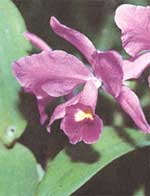Catleya / cattleya
Refers to the family of orchids. Fatherland is Central and South America.
General description: Katlei in nature grow on trees, i.e. Are epiphytic plants. They have thick, scaly-covered stems, at the base receiving onion form (pseudobulbs). Leaves are leathery, oblong. Large waxy flowers (10-15 cm in diameter) are collected in the racemose apical inflorescence. Paint petals are snow-white, pink or lilac. Sepals are much narrower than petals and have undulating margins. The lip (lower petal) of a three-lobed flower, the middle lobe is violet-purple in color, with a curly margin, with a bright yellow throat.
Catley is better to grow in the terrarium, as if it requires a constant temperature and a very high humidity of the atmosphere.
Recommendations for the care of the plant Katleia:
Illumination : Needs bright, but diffused light.
Irrigation regime : Abundant during growth, moderate in winter.
Humidity : Humidity is maintained by placing pots on a pallet with pebbles or expanded clay, which is continuously moistened. You can grow in a pool with a poured on the bottom of the water. Katleia loves a fresh atmosphere.
Temperature regime : Katleya adores heat, in summer it is optimal 22-28 ° С, in winter 16-18 ° С.
Soil : Proper benign drainage is required. You can add charcoal or expanded clay.
Recommended soil mixture: 1 share of peat moss, 1 share of chopped pine bark. A mishmash for orchids will do.
During the growth period, you need regular fertilizing for orchids or usual in half of the portion indicated on the package.
Breeding : Crushing during transplantation. In each element there should be no less than three sprouts.
Transplantation : Catley is transplanted at what time the roots growing at the base, will grow by half a centimeter. You do not need to land heavily in the ground.
Pests : affected by scutes (brown plaques appear on leaves and stems, leaving sticky excretions), aphids (they form sticky excretions on shoot tips, buds), thrips (grayish dots appear on the leaves).
The plant is allowed to help finish with a soap solution, warm washing and spraying with an actinic (1-2 ml per liter of water).


Cattleya - cattleya
Cattleya labia
Cattleya bowringia - cattleya bowringiana


Comments
Commenting on, remember that the content and tone of your message can hurt the feelings of real people, show respect and tolerance to your interlocutors even if you do not share their opinion, your behavior in the conditions of freedom of expression and anonymity provided by the Internet, changes Not only virtual, but also the real world. All comments are hidden from the index, spam is controlled.